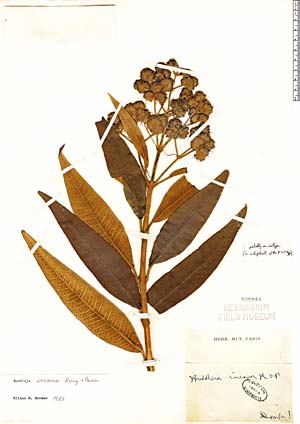Buddleja incana
Buddleja incana is a species of the genus Buddleia ( Buddleia ) in the family of the figwort family ( Scrophulariaceae ). It is native to the Andes.
Description
Buddleja incana grows as a tree reaching heights of growth 7-15 meters. The bark of the branches is whitish hairs. Its leaves are oblong, lanceolate and slightly serrated. The stipules are margins.
In little head shaped inflorescences many flowers are borne. The cup is sharply toothed and white to yellow flowers crown open.
Trivial names
In Quechua, this type is called Kiswar ( as in all dialects of Peru and Bolivia ), Kishwar Kichwa of Ecuador and in Aymara kiswara. Therefore, the Spanish definitions derive quisoar, quisuar and Quishuar (pronounced kisuar ) from. These names are, however - partly in combinations such as puna Kiswar ( Buddleja coriacea ) - used for other Buddleia species. To distinguish Buddleja incana is therefore given its relative size as hatun Kiswar ( " large Buddleia " ) referred.
Dissemination
Buddleja incana growing in the Andes (Bolivia, Peru, Ecuador and Colombia), at an altitude of about 2500-3600 meters, which corresponds according to Javier Pulgar Vidal height zone Quechua.
Kiswar was at the time of the Incas, the most important forest tree ( mallki in contrast to wild -growing trees sach'a ). Since then, the stock of Kiswar or is used for firewood, timber and grazing has declined sharply. Place names in the Andean region bear witness to the former presence of the tree in areas where it is impossible to find today.
Buddleja incana is intended for reforestation activities in the Andean region, together with also native Polylepis and Escallonia species, Schinus molle and Buddleja coriacea.
Use
Buddleja incana is estimated to be particularly hard wood, traditional tools are made from, such as " Fußpflug " ( chakitaklla ), but also spoons and ladles and bowls of chicha production. The Incas also carved ceremonial items such as figurines and wooden cups ( qiru ), some of which were burned in large numbers as offerings.
The leaves are traditionally used for envelopes for toothache; its infusion is used as a diuretic. The flowers are traded under the name "Flor Blanca " ( "White Flower " ) as a natural remedy for vaginal discharge.
System
This species was first described by the Spanish botanists Hipólito Ruiz López and José Antonio Pavón y Jiménez and published in 1798.
Synonyms for Buddleja incana Ruiz & Pav are: Buddleja bullata Kunth, Buddleja incana var pannulosa Diels, Buddleia longifolia Kunth, Buddleja rugosa Kunth.






.jpg)
